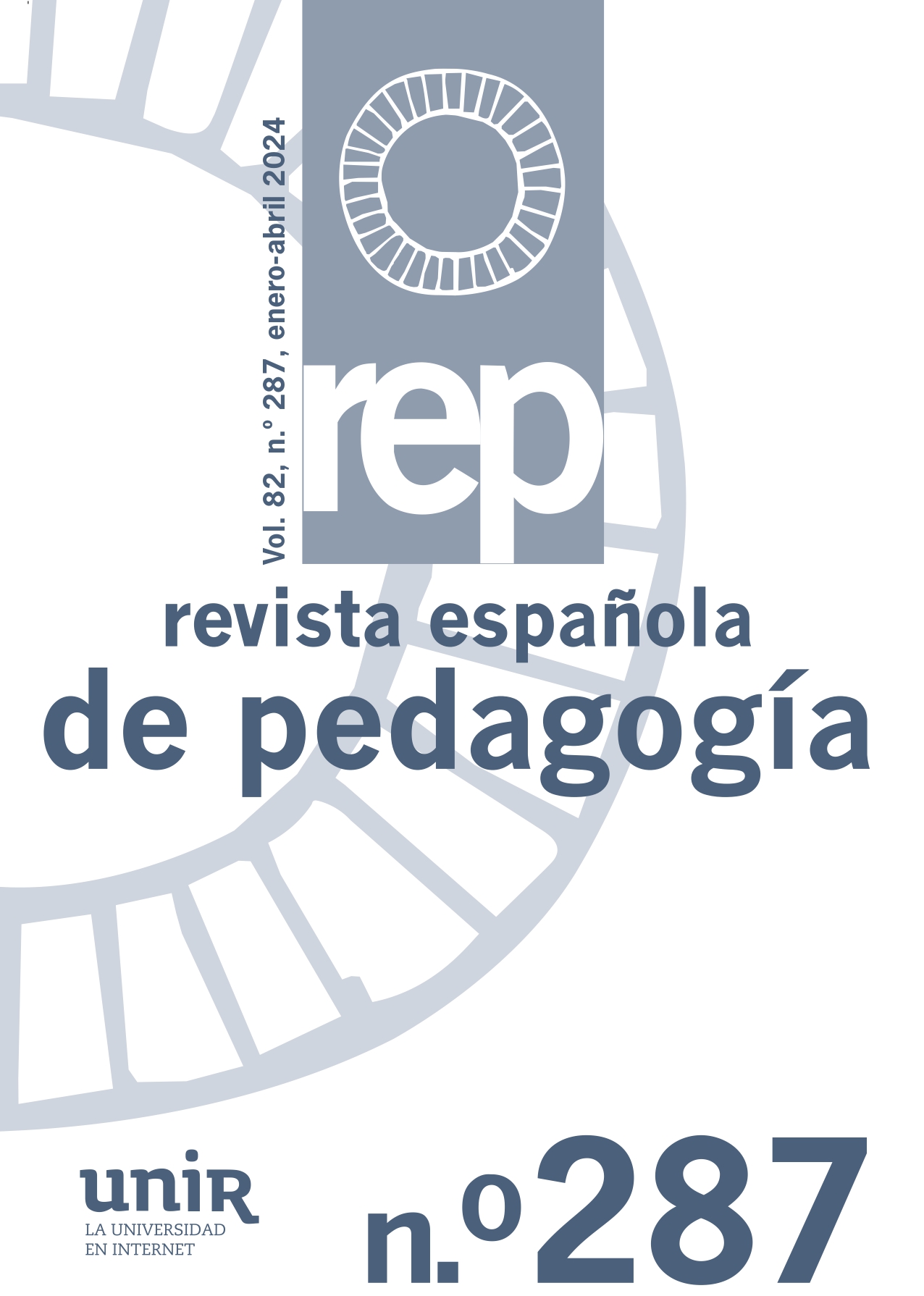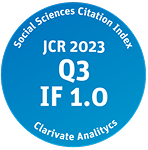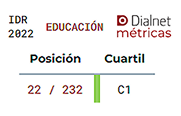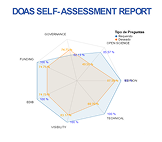Efficacy indicators for ICT addiction prevention: a case study of Clickeando.
DOI:
https://doi.org/10.22550/2174-0909.3930Keywords:
addiction, technology, ICT, mobile phones, social networks, video games, school-based prevention, prevention programme, mental health, efficacy, validation, adolescence, Covid-19, factor analysisAbstract
There are few programmes for preventing ICT addiction, and even fewer that have been scientifically validated. Preventing ICT addiction is a key part of governments’ adolescent mental health policies. Clickeando is a school programme for universal prevention of ICT addiction in adolescents. It has been in use for fourteen years and was designed on the basis of the appropriate quality indexes for this type of programme. Since 2020, Clickeando has assessed its participants with the aim of linking the efforts of different preventive bodies and agents. This has enabled the present study to assess the programme’s impact on its target population. The main results indicate that the programme produces changes in ICT use, principally by reducing addictive use of mobile phones by girls and boys in secondary education. Likewise, there are important behaviours in the development of addictive patterns that we suggest should be the focus of future modifications to the workshop (such as time spent on social networks or on instant messaging systems), for they are crucial for the efficacy of the intervention. The effects of Covid-19 on young people’s mental health have highlighted the need for assessment protocols and preventive actions that foster healthy use of technology and that take into account age and the gender perspective in their implementation to maximise their efficacy.
Downloads
References
American Psychiatric Association (2013). Diagnostic and statistical manual of mental disorders, DSM-5 [Manual diagnóstico y estadístico de los trastornos mentales, DSM-5]. American Psychiatric Publishing.
American Psychological Association. (2014). Guidelines for prevention in psychology [Directrices para la prevención en psicología]. American Psychologist, 69 (3), 285-296. https://doi.org/10.1037/a0034569
Anderson, M., y Jiang, J. (2018, 31 de mayo). Teens, social media and technology 2018 [Adolescentes, redes sociales y tecnología 2018]. Pew Research Center. https://www.pewresearch.org/internet/2018/05/31/teens-social-media-technology-2018/
Andreassen, C. S., Billieux, J., Griffiths, M. D., Kuss, D. J., Demetrovics, Z., Mazzoni, E., y Pallesen, S. (2016). The relationship between addictive use of social media and video games and symptoms of psychiatric disorders: A large-scale cross-sectional study [La relación entre el uso adictivo de las redes sociales y los videojuegos y síntomas de trastornos mentales: Estudio transversal a gran escala]. Psychology of Addictive Behaviors, 30 (2), 252-262. https://doi.org/10.1037/adb0000160
Bashir, H., y Bhat, S. A. (2017). Effects of social media on mental health: A review [Efectos de las redes sociales en la salud mental: Una revisión]. International Journal of Indian Psychology, 4 (3), 125-131. https://doi.org/10.25215/0403.134
Berrios, B., Pérez, B., Sánchez, F., y Pantoja, A. (2020). Análisis del programa educativo «Cubilete» para la prevención de adicciones a TIC en adolescentes. Caso específico de juegos de azar y apuestas online. Revista Española de Orientación y Psicopedagogía (REOP), 31 (1), 26-42. https://doi.org/10.5944/reop.vol.31.num.1.2020.27289
Bhargava, R., y Seshadri, S. (2021). Screen use and behavioral addiction: Making the «porridge» healthy [Uso de pantallas y adicción conductual: hacer las «gachas» saludables]. Indian Journal of Social Psychiatry, 37 (3), 245-247. https://doi.org/10.4103/ijsp.ijsp_272_21
Cartanyà-Hueso, À., Lidón-Moyano, C., y Martínez-Sánchez, J. M. (2021). Tiempo y uso de pantallas en niños y adolescentes: revisión y comparación de las guías de cinco instituciones sanitarias. Boletín de Pediatría, 61 (257), 174-179. https://sccalp.org/uploads/bulletin_article/pdf_version/1639/BolPediatr2021_61_174-179.pdf
Chóliz, M. (2010). Mobile phone addiction in adolescence: Evaluation and prevention of mobile addiction in teenagers [Adicción al teléfono móvil en la adolescencia: evaluación y prevención de la adicción al móvil en adolescentes]. Lambert Academic Publishing.
Chóliz, M. (2017). Prevención de las adicciones tecnológicas en la adolescencia. Padres y Maestros / Journal of Parents and Teachers, (369), 53-59. https://doi.org/10.14422/pym.i369.y2017.008
Clement, J. (2023, 14 de noviembre). Number of video gamers worldwide 2017-2027 [Número de videojugadores a nivel mundial 2017-2027]. Statista. https://www.statista.com/statistics/748044/number-video-gamers-world/
Echeburúa, E., y De Corral, P. (2010). Adicción a las nuevas tecnologías y a las redes sociales en jóvenes: un nuevo reto. Adicciones, 22 (2), 91-95. https://doi.org/10.20882/adicciones.196
Espinel, S. P., y Leguizamón, M. C. (2022). Adicción a internet en tiempos de COVID-19. Programa de prevención. Revista Virtual Universidad Católica del Norte, (67), 191-216. https://www.doi.org/10.35575/rvucn.n67a8
Gainsbury, S., y Blaszczynski, A. (2011). A systematic review of Internet-based therapy for the treatment of addictions [Una revisión sistemática de la terapia para el tratamiento de las adicciones basada en Internet]. Clinical Psychology Review, 31 (3), 490-498. https://doi.org/10.1016/j.cpr.2010.11.007
García-Couceiro, N., Gómez, P., Kim-Harris, S., Burkhart, G., Flórez-Menéndez, G., y Rial, A. (2021, 19 de mayo). El modelo SBIRT como estrategia de prevención de las adicciones con y sin sustancia en adolescentes. Revista Española de Salud Pública, (95), e202105065. https://www.sanidad.gob.es/biblioPublic/publicaciones/recursos_propios/resp/revista_cdrom/VOL95/C_ESPECIALES/RS95C_202105065.pdf
Gentry, J. H., y Campbell, M. (2002). Developing adolescents: A reference for professionals [Adolescentes en desarrollo: una referencia para profesionales]. American Psychological Association. https://www.apa.org/pi/families/resources/develop.pdf
Griffiths, M. (1995). Technological addictions [Adicciones tecnológicas]. Clinical Psychology Forum, (76), 14-19. https://doi.org/10.53841/bpscpf.1995.1.76.14
Kaess, M., Parzer, P., Brunner, R., Koenig, J., Durkee, T., Carli, V., Wasserman, D., Hoven, C. W., Sarchiapone, M., Bobes, J., Cosman, D., Värnik, A.Resch, F., y Wasserman, D. (2016). Pathological internet use is on the rise among European adolescents [El uso patológico de internet está aumentando entre adolescentes europeos]. Journal of Adolescent Health, 59 (2), 236- 239. https://doi.org/10.1016/j.jadohealth.2016.04.009
Killian, M. O., Cimino, A. N., Weller, B. E., y Hyun Seo, C. (2019). A systematic review of latent variable mixture modeling research in social work journals [Una revisión sistemática de la mezcla de variables latentes en revistas de trabajo social]. Journal of Evidence-Based Social Work, 16 (2), 192-210. https://doi.org/10.1080/23761407.2019.1577783
King, D. L., Delfabbro, P. H., Doh, Y. Y., Wu, A. M., Kuss, D. J., Pallesen, S., Mentzoni, R., Carragher, N., y Sakuma, H. (2018). Policy and prevention approaches for disordered and hazardous gaming and Internet use: An international perspective [Enfoques políticos y preventivos para el trastorno y los problemas con los videojuegos y el uso de Internet: una perspectiva internacional]. Prevention Science, 19 (2), 233-249. http://doi.org/10.1007/s11121-017-0813-1
Kline, R. B. (2010). Promise and pitfalls of structural equation modeling in gifted research [Promesas y obstáculos en el modelo de ecuaciones estructurales en superdotados]. En B. Thompson, y R. F. Subotnik (Eds.), Methodologies for conducting research on giftedness [Metodologías para investigar la superdotación] (pp. 147-169). American Psychological Association. https://doi.org/10.1037/12079-00
Kuss, D. J., Van Rooij, A. J., Shorter, G. W., Griffiths, M. D., y Van de Mheen, D. (2013). Internet addiction in adolescents: Prevalence and risk factors [Adicción a internet en adolescentes: prevalencia y factores de riesgo]. Computers in Human Behavior, 29 (5), 1987-1996. http://dx.doi.org/10.1016/j.chb.2013.04.002
Kuss, D. J., Shorter, G. W., Van Rooij, A. J., Van de Mheen, D., y Griffiths, M. D. (2014). The Internet addiction components model and personality: Establishing construct validity via a nomological network [El modelo de componentes de la adicción a Internet y la personalidad: establecer la validez de constructo mediante una red nomológica]. Computers in Human Behavior, 39, 312-321. http://dx.doi.org/10.1016/j.chb.2014.07.031
Kuss, D. J., y Griffiths, M. D. (2017). Social networking sites and addiction: Ten lessons learned [Páginas de redes sociales y adicción: diez lecciones aprendidas]. International journal of environmental research and public health, 14 (3), 311. https://doi.org/10.3390/ijerph14030311
Luján-Barrera, A., y Denís, M. (2022). Adicción al móvil e impulsividad: ¿cuánto tardas en responder un mensaje de WhatsApp? Informació psicològica, (123), 24-38. https://doi.org/10.14635/IPSIC.1924
Ma, H. K., Chu, M. K., y Chan, W. W. (2011). Construction of a teaching package on promoting prosocial internet use and preventing antisocial internet use [Construcción de un paquete didáctico sobre la promoción del uso prosocial de internet y la prevención del uso antisocial del internet]. The Scientific World Journal, 11, 2136-2146. https://doi.org/10.1100/2011/672898
Marcos, M., y Chóliz, M. (2021). TecnoTest: desarrollo de una herramienta de screening de adicciones tecnológicas y juego. Adicciones, 35 (3), 235-248. https://doi.org/10.20882/adicciones.1380
Masaeli, N., y Farhadi, H. (2021). Prevalence of internet-based addictive behaviors during COVID-19 pandemic: A systematic review [Prevalencia de las conductas adictivas basadas en internet durante la pandemia del COVID-19: una revisión sistemática]. Journal of Addictive Diseases, 39 (4), 468-488. https://doi.org/10.1080/10550887.2021.1895962
Mora, F., Dolengevich, H., y Quintero, J. (2015). Protocolo de tratamiento de las adicciones sin sustancia psicoactiva. Medicine - Programa de Formación Médica Continuada Acreditado, 11 (86), 5157-5160. https://doi.org/10.1016/j.med.2015.09.006
Naskar, S., Victor, R., Nath, K., y Sengupta, C. (2016). «One level more:» A narrative review on internet gaming disorder [«Un nivel más»: una revisión narrativa del trastorno de videojuegos por internet]. Industrial Psychiatry Journal, 25 (2), 145-154. https://doi.org/10.4103/ipj.ipj_67_16
Observatorio Español de las Drogas y las Adicciones. (2022). Informe sobre trastornos comportamentales 2022: juego con dinero, uso de videojuegos y uso compulsivo de internet en las encuestas de drogas y otras adicciones en España EDADES y ESTUDES. Ministerio de Sanidad. Delegación del Gobierno para el Plan Nacional sobre Drogas. https://pnsd.sanidad.gob.es/profesionales/sistemasInformacion/sistemaInformacion/pdf/2022_Informe_Trastornos_Comportamentales.pdf
Petrosyan, A. (2023, 25 de octubre). Worldwide digital population 2023 [Población digital mundial 2023]. Statista. https://www.statista.com/statistics/617136/digital-population-worldwide/
Prats, M. Ángel, Torres-Rodríguez, A., Oberst, U., y Carbonell, X. (2018). Diseño y aplicación de talleres educativos para el uso saludable de internet y redes sociales en la adolescencia: descripción de un estudio piloto. Pixel-Bit. Revista de Medios y Educación, (52), 111-124. https://doi.org/10.12795/pixelbit.2018.i52.08
Romano, J. L., y Hage, S. M. (2000). Prevention: A call to action [Prevención: una llamada a la acción]. The Counseling Psychologist, 28 (6), 854-856. https://doi.org/10.1177/0011000000286007
Sánchez, L., Benito, R., Serrano, A., Benavent, R. A., y Bueno, F. J. (2018). Programa de prevención del uso problemático de internet y redes sociales. «Clickeando». Unidad de Prevención Comunitaria en Conductas Adictivas (UPCCA-València); Plan Municipal de Drogodependencias y Otros Trastornos Adictivos (PMD); Concejalía de Sanidad, Salud y Deportes. Ayuntamiento de Valencia.
Soto, A., De Miguel, N., y Pérez-Díaz, V. (2018). Abordaje de adicciones a nuevas tecnologías: una propuesta de prevención en contexto escolar y tratamiento de rehabilitación. Papeles del Psicólogo, 39 (2), 120-126. https://doi.org/10.23923/pap.psicol2018.2867
Stevens, J. P. (2002). Applied multivariate statistics for the social sciences [Estadística multivariada aplicada a las ciencias sociales] (4.ª ed.). Lawrence Erlbaum Associates. https://psycnet.apa.org/record/2001-18534-000
Sussman, S., Lisha, N., y Griffiths, M. (2011). Prevalence of the addictions: a problem of the majority or the minority? [Prevalencia de las adicciones: ¿un problema de la mayoría o de la minoría?]. Evaluation & the Health Professions, 34 (1), 3–56. https://doi.org/10.1177/0163278710380124
Taylor, P. (2023). Forecast number of mobile users worldwide 2020- 2025 [Previsión del número de usuarios de teléfono móvil a nivel mundial 2020-2025]. Statista. https://www.statista.com/statistics/218984/number-of-global-mobile-users-since-2010/
Throuvala, M. A., Griffiths, M. D., Rennoldson, M., y Kuss, D. J. (2019). School-based prevention for adolescent internet addiction: Prevention is the key. A systematic literature review [Prevención escolar para adolescentes con adicción a internet: la prevención es la clave. Una revisión bibliográfica sistemática]. Current Neuropharmacology, 17 (6), 507-525. https://doi.org/10.2174/1570159X16666180813153806
Van de Schoot, R., Lugtig, P., y Hox, J. (2012). A checklist for testing measurement invariance [Lista de control para comprobar la invariabilidad de las mediciones]. European Journal of Developmental Psychology, 9 (4), 486-492. https://doi.org/10.1080/17405629.2012.686740
Van den Eijnden, R. J., Lemmens, J. S., y Valkenburg, P. M. (2016). The social media disorder scale [La escala del trastorno de las redes sociales]. Computers in human behavior, 61, 478-487. https://doi.org/10.1016/j.chb.2016.03.038
Yudes, C., Rey Peña, L., y Extremera Pacheco, N. (2019). Ciberagresión, adicción a internet e inteligencia emocional en adolescentes: un análisis de diferencias de género. Voces de la Educación, (2) 27-44. https://www.revista.vocesdelaeducacion.com.mx/index.php/voces/article/view/210
Zhao, H., Li, X., Zhou, J., Nie, Q., y Zhou, J. (2020). The relationship between bullying victimization and online game addiction among Chinese early adolescents: The potential role of meaning in life and gender differences [La relación entre la victimización por acoso y la adicción a los juegos en línea en la adolescencia temprana en China: el papel potencial del sentido de la vida y las diferencias de género]. Children and Youth Services Review, 116, 105261. https://doi.org/10.1016/j.childyouth.2020.105261
Downloads
Published
-
Abstract62
-
PDF (Español)55
-
PDF55
How to Cite
Issue
Section
License

This work is licensed under a Creative Commons Attribution-NonCommercial 4.0 International License.










